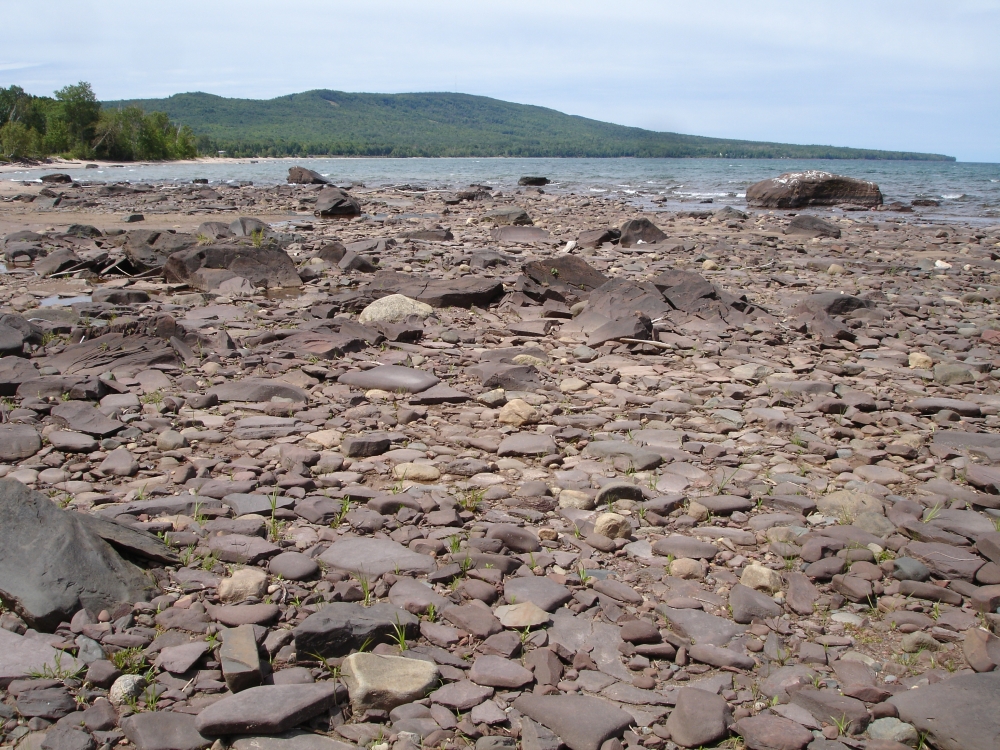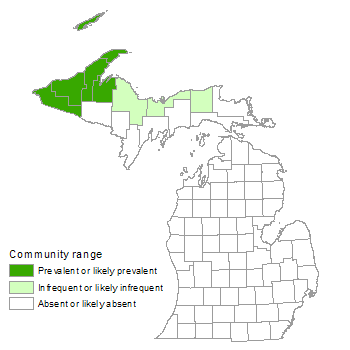Sandstone Cobble Shore
Overview
Sandstone cobble shore is a sparsely vegetated community that occupies the edges of Lake Superior, predominantly occurring in coves and gently curving bays in association with bedrock cliff, bedrock outcrop, sandstone bedrock lakeshore, and sand and gravel beach. These cobble shores may be nearly level and support a diversity of herbaceous plants where they border sand and gravel beach or relatively steep and terraced in coves between bedrock outcrops, with vegetation mostly limited to the highest cobble beach ridge, where scattered trees and shrubs are dominant. Sandstone cobble shore is dominated by flat, round-sided sandstones that move readily when subject to intense wave action, limiting soil development and vegetation establishment.
Rank
Global Rank: G2G3 - Rank is uncertain, ranging from imperiled to vulnerable
State Rank: S2 - Imperiled

Landscape Context
Sandstone cobble shore occurs along the edges of Lake Superior as part of the Copper Harbor Conglomerate, Jacobsville Sandstone, and Nonesuch and Freda Formations. This type of cobble shore includes a combination of siltstones and shales in addition to sandstones, and is found along the shores of Lake Superior in the United States and Canada, including Michigan, Minnesota, Wisconsin, and Ontario. In Michigan, sandstone cobble shore occurs at the east end of Pictured Rocks National Lakeshore, along the Keweenaw Peninsula and Point Abbaye, and within and near Porcupine Mountains Wilderness State Park.
Sandstone cobble shores are typically bordered along their inland margin by boreal forest, mesic northern forest, and occasionally by forested wetlands. Along the shoreline, they may be interspersed with areas of sandstone bedrock lakeshore, sandstone lakeshore cliff, granite bedrock lakeshore, granite lakeshore cliff, volcanic bedrock lakeshore, volcanic cobble shore, and sand and gravel beach.
Soils
Little or no soil development occurs on sandstone cobble shore. The few plants that establish are rooted in sand and gravel deposits under the coarse cobble. The size of the weathered and eroded sandstone cobbles ranges from 2 to 3 cm (0.75 to 1.0 in) in diameter to over 20 cm (8 in) in diameter, and large sandstone and conglomerate boulders or slabs can be common.
Natural Processes
Storm waves, ice scour, and desiccation are the primary forms of natural disturbance. The flat-sided sandstones are easily moved and rearranged by storm waves and ice movement, which form and remove terraces, uproot and bury plants, and limit soil development. In addition to a lack of soil, plant establishment in deep cobble is limited by desiccating conditions during summer droughts as a result of full exposure to sun and wind. Groundwater seepage, storm waves, and streams, both perennial and intermittent, provide a source of moisture for vegetation in some areas of the community. Windthrow is common along the inland forested edge due to strong winds associated with Lake Superior storms.
Vegetation
Sandstone cobble shore is a sparsely vegetated community. The community may occur as a steep terraced ridge in protected coves and gently curving bays between bedrock shorelines or cliffs, or occasionally as nearly level, frequently inundated cobble beaches with large stranded slabs of sandstone and conglomerate bedrock. On steeply terraced sandstone cobble shores, very few plants are able to establish except along the upper beach ridge, in moist areas of groundwater seepage, and along small streams. Plants growing along the upper cobble beach ridge include a variety of scattered trees and shrubs such as paper birch (Betula papyrifera), northern white-cedar (Thuja occidentalis), quaking aspen (Populus tremuloides), American highbush cranberry (Viburnum trilobum), thimbleberry (Rubus parviflorus), and raspberries (Rubus spp.). Species occurring in the wet areas of steep sandstone cobble shore include sedge (Carex crinita), water-hemlock (Cicuta maculata), common horsetail (Equisetum arvense), rattlesnake grass (Glyceria canadensis), jewelweed (Impatiens capensis), northern bugleweed (Lycopus uniflorus), and common skullcap (Scutellaria galericulata). On nearly level, frequently inundated sandstone cobble shore common plant species include water plantain (Alisma triviale), sedge (Carex viridula), water-hemlocks (C. bulbifera and C. maculata), grass-leaved goldenrod (Euthamia graminifolia), boneset (Eupatorium perfoliatum), joe-pye-weed (Eutrochium maculatum), jewelweed, common water horehound (Lycopus americanus), northern bugleweed (L. uniflorus), smartweeds (Persicaria spp.), pondweeds (Potamogeton spp.), rushes (Juncus spp.), arrowhead (Sagittaria latifolia), and water parsnip (Sium suave). The large sandstone and conglomerate slabs stranded along the cobble shore support a similar species composition as that found on sandstone bedrock lakeshore, including hair grass (Deschampsia cespitosa), upland white goldenrod (Solidago ptarmicoides), Gillman’s goldenrod (S. simplex), balsam ragwort (Packera paupercula), and wild strawberry (Fragaria virginiana).
For information about plant species, visit the Michigan Flora website.
Plant Lists
Graminoids
- fringed sedge (Carex crinita)
- little green sedge (Carex viridula)
- tufted hair grass (Deschampsia cespitosa)
- rattlesnake grass (Glyceria canadensis)
- Baltic rush (Juncus balticus)
- knotted rush (Juncus nodosus)
Forbs
- water plantain (Alisma triviale)
- bulblet-bearing water hemlocks (Cicuta bulbifera)
- fireweed (Chamerion angustifolium)
- spotted water hemlock (Cicuta maculata)
- common boneset (Eupatorium perfoliatum)
- grass-leaved goldenrod (Euthamia graminifolia)
- joe-pye-weed (Eutrochium maculatum)
- wild strawberry (Fragaria virginiana)
- jewelweed (Impatiens capensis)
- marsh pea (Lathyrus palustris)
- common water horehound (Lycopus americanus)
- northern bugle weed (Lycopus uniflorus)
- balsam ragwort (Packera paupercula)
- smartweeds (Persicaria spp.)
- common arrowhead (Sagittaria latifolia)
- common skullcap (Scutellaria galericulata)
- water parsnip (Sium suave)
- upland white goldenrod (Solidago ptarmicoides)
- Gillman’s goldenrod (Solidago simplex)
Fern Allies
- common horsetail (Equisetum arvense)
Shrubs
- mountain alder (Alnus viridis)
- ninebark (Physocarpus opulifolius)
- thimbleberry (Rubus parviflorus)
- wild red raspberry (Rubus strigosus)
- American highbush-cranberry (Viburnum trilobum)
Trees
- paper birch (Betula papyrifera)
- green ash (Fraxinus pennsylvanica)
- balsam poplar (Populus balsamifera)
- quaking aspen (Populus tremuloides)
- northern white-cedar (Thuja occidentalis)
Noteworthy Animals
The high-energy environment of the cobble shore appears to provide little stable habitat for terrestrial insects, but the sediments and rock surfaces are sometimes rich in aquatic invertebrates.
Rare Plants
None documented.
Rare Animals
None documented.
Biodiversity Management Considerations
Off-road vehicles (ORVs) can destroy vegetation growing in sandstone cobble shores, further reducing diversity. Eliminating illegal ORV activity is a primary means of protecting sandstone cobble shores. Maintaining a forested buffer will help prevent soil erosion and runoff into the community and may help reduce the local seed source of non-native invasive plants. Like other natural communities, monitoring and control efforts to detect and remove invasive plants will help protect the ecological integrity of sandstone cobble shore. Several invasive species that may have potential to colonize the community include reed (Phragmites australis subsp. australis), glossy buckthorn (Frangula alnus), and multiflora rose (Rosa multiflora).
Variation
Community structure and species composition are strongly influenced by the sizes and types of cobble, steepness of shoreline slope, and presence or absence of terracing, groundwater seepage, and streams. Geological differences in sandstone bedrock along Lake Superior cause variability in cobble texture and erosion resistance, which in turn influences soil development and vegetation establishment. Sandstone cobble shore also includes cobbles formed from finer siltstone and shale. Siltstones occur along the west shore of the Keweenaw Peninsula, and small exposures of shale occur farther west along the Porcupine Mountains’ shoreline. Low shale ledges are also present along the southwestern shoreline of Lake Huron, but no well developed cobble shores are known from this area.
Similar Natural Communities
Volcanic cobble shore, limestone cobble shore, sandstone bedrock lakeshore, sandstone lakeshore cliff, and sand and gravel beach.
Places to Visit
- Point Abbaye, Baraga State Forest Management Unit, Baraga Co.
- Porcupine Shore, Porcupine Mountains Wilderness State Park, Ontonagon Co.
- Sleeping Misery Bay, Baraga State Forest Management Unit, Ontonagon Co.
Relevant Literature
- Albert, D.A., P. Comer, D. Cuthrell, D. Hyde, W. MacKinnon, M. Penskar, and M. Rabe. 1997. The Great Lakes bedrock lakeshores of Michigan. Michigan Natural Features Inventory, Lansing, MI. 218 pp.
- Bornhorst, T.J., and W.I. Rose. 1994. Self-guided geological field trip to the Keweenaw Peninsula, Michigan. Proceedings of the Institute on Lake Superior Geology. Volume 40, Part 2. 185 pp.
- Dorr, J.A., Jr., and D.F. Eschman. 1970. Geology of Michigan. University of Michigan Press, Ann Arbor, MI. 470 pp.
- Faber-Langendoen, D., ed. 2001. Plant communities of the Midwest: Classification in an ecological context. Association for Biodiversity Information, Arlington, VA. 61 pp. + appendix (705 pp.).
- LaBerge, G.L. 1994. Geology of the Lake Superior region. Geoscience Press, Phoenix, AZ. 313 pp.
- Reed, R.C., and J. Daniels. 1987. Bedrock geology of northern Michigan. State of Michigan Department of Natural Resources. Map: 1: 500,000.
Citation
Cohen, J.G., M.A. Kost, B.S. Slaughter, D.A. Albert, J.M. Lincoln, A.P. Kortenhoven, C.M. Wilton, H.D. Enander, and K.M. Korroch. 2020. Michigan Natural Community Classification [web application]. Michigan Natural Features Inventory, Michigan State University Extension, Lansing, Michigan. Available https://mnfi.anr.msu.edu/communities/classification. (Accessed: April 19, 2024).
Kost, M.A., D.A. Albert, J.G. Cohen, B.S. Slaughter, R.K. Schillo, C.R. Weber, and K.A. Chapman. 2007. Natural Communities of Michigan: Classification and Description. Michigan Natural Features Inventory, Report No. 2007-21, Lansing, MI.


